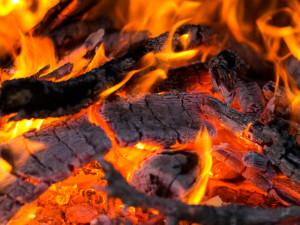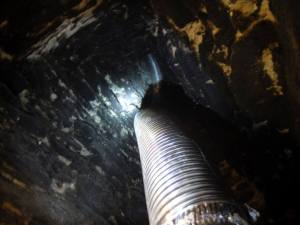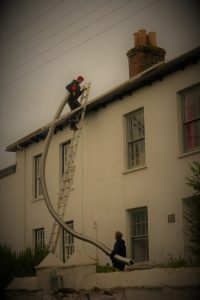When given a chance to reline a flue, we will always strongly advise that it is taken.
Most manufacturers insist their stoves are fitted with liners as they improve safety and efficiency. For the sake of about £200.00 extra, the approximate cost is relatively insignificant if you are seriously thinking of updating your solid fuel heating system; you can purchase one of the most advanced types of solid fuel stove (Eco Design Ready) from as little as £500.00.
Flexible flue liners are for the most part much narrower and smoother than your existing flue. They are also cylindrical. This means that they are designed to remove the waste products of your fire better. Flexible flue liners also protect your existing flue and are easier to clean. This has huge safety implications.
When we talk about flues, we need to bear in mind that flues were typically designed for open fires. Aside from looking nice, open fires were pretty useless at generating heat (into your room anyway!). About 80% of the heat produced was lost up the flue. The purpose of a flue is to remove the many waste products of fire. Heat rises and carries waste products with it. Consequently, as open fires produced a lot of heat within a flue, most waste products were expelled into the atmosphere.
The problem with modern stoves is that they are incredibly efficient. Put a log on the fire, and you’ll get about 80% of the heat generated from that log in your room. This means that there’s not much heat generated up your flue. This is a problem when you need to expel waste products. Especially if your existing chimney is large, damaged or even square.

Flues built before 1968 were traditionally made with brick and stone. They were usually wide and housed lots of nooks and crannies. This meant they were always hard to clean and are typically found to be in a state of disrepair, generally caused by the by-products of fire.
Most houses built after 1968 had clay and pumice liners fitted – which were square, rectangular or cylindrical in shape with varying diameters, typically between 7”-12”. We sometimes see these flues fitted incorrectly (upside down and disjointed) or once again damaged through the effect of having a fire combined with poor techniques and fuels. In any case, the flue diameter is too large to be useful for a modern day stove.
As I’ve stated above, the purpose of a flue is to remove the many waste products of fire. These include smoke, Carbon Monoxide (CO), ash, soot, particulate emissions, water and tar.
Some of these waste products are also very corrosive seeping through the mortar and brickwork, staining and creating holes for the poisonous gasses to escape. Evidence of this can be seen on the side of a house where the flue passes. Imagine what’s going on behind your bedroom wall if the chimney passes behind it? We regularly see evidence of failure on top of the stack – the bricks and mortar dividing flues have entirely collapsed, pointing has failed, and general degeneration is apparent.
Burning coal and wood at the same time produces a substance called creosote. This is a tar-like substance that is sticky and flammable. It coats the insides of flues easily and builds up fast. It is a primary cause of chimney fires. Burning a wet log (above 20% moisture content), and allowing your fire to slumber can also generate creosote. These burning techniques were – and still, are – standard practice. Yet it is completely inadvisable. How many years has your flue been subject to this abuse through innocent and incorrect use?
Furthermore – how often has your flue been swept? All three major sweeping organisations in the UK state that your flue should be swept every 3 months of continued use. Even so, the effectiveness of traditional sweeping methods is being questioned. Most modern-day sweeps use power sweeping techniques that are proven to be far more effective. Thus ensuring your flue is cleaned more thoroughly.
Therefore by relining your chimney, you will be protecting the existing flue from the build-up of these waste products over the years. You’ll also be protecting yourself, your family and your neighbours.

Even if you have a brand new clay liner, we would still choose to install a flue liner. It will ensure that the original flue is protected, but it will also improve the draw and consequently the performance of the stove.
Stoves are effective when their flue draws well. Straight and tall flues have a good draw. Keeping the diameter of the flue as close to the diameter of the stove outlet also improves the draw. For example, a 6” diameter outlet on a stove is best suited with a 6” diameter flue system. Even increasing the flue diameter to 7” can cause issues and compromise the draw. Let’s not forget that your stove will likely be very efficient, so the amount of heat within your flue is significantly less than it would be from having an open fire. The more space within the flue, the more heat is required to keep the airflow moving upwards.
Stoves need all the help they can get to expel the smoke and waste products. If the draw is poor, smoke can back up within the chimney. Your stove will struggle, and smoke will start coming out of the vents or even the door when you try and load up fuel.
All flue liners are designed to connect from the flue pipe or the stove at the bottom to the cowl at the top. It’s a wholly contained flue system that is designed to improve the draw and the effectiveness of your stove.
A flexible flue liner is classified as temporary. The conditional warranties vary between 10 and 30 years. There are made of stainless steel, and there are two grades of liner – one for wood burning, and one for multifuel burning (wood and smokeless fuel). We only use Duraflue liners as we think they are the best liners available on the market.
If your liner is installed correctly, you burn the right fuels, operate your stove correctly, and have it swept regularly; your liner should last considerably longer than the warranty. And you’ll be ensuring air quality is maintained too.

As Blazing Burners is HETAS registered, be assured that building regulations will be followed, a CO alarm is fitted, and your installation is certified for insurance purposes.
